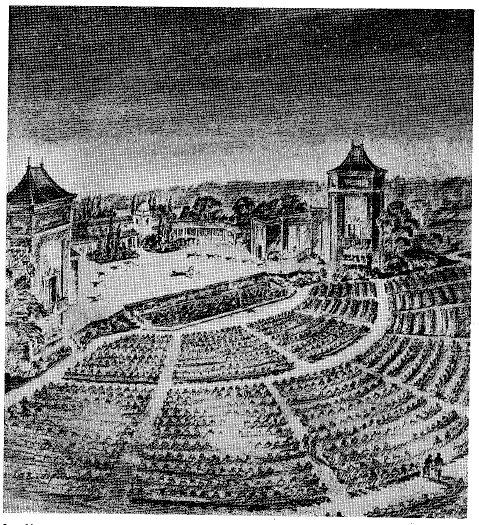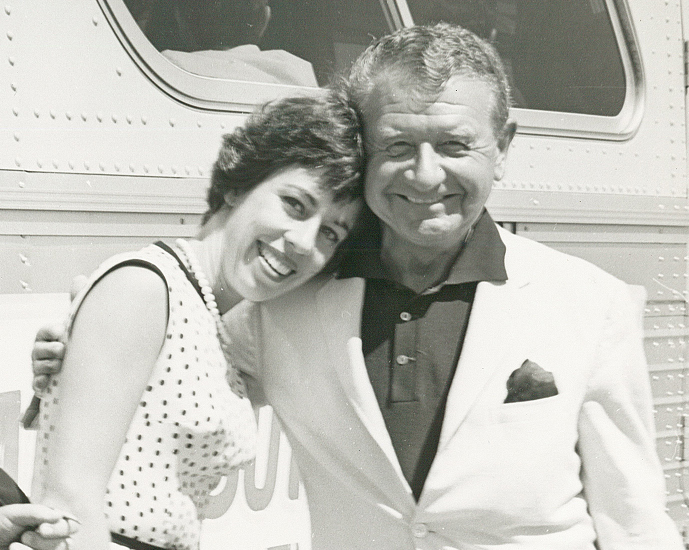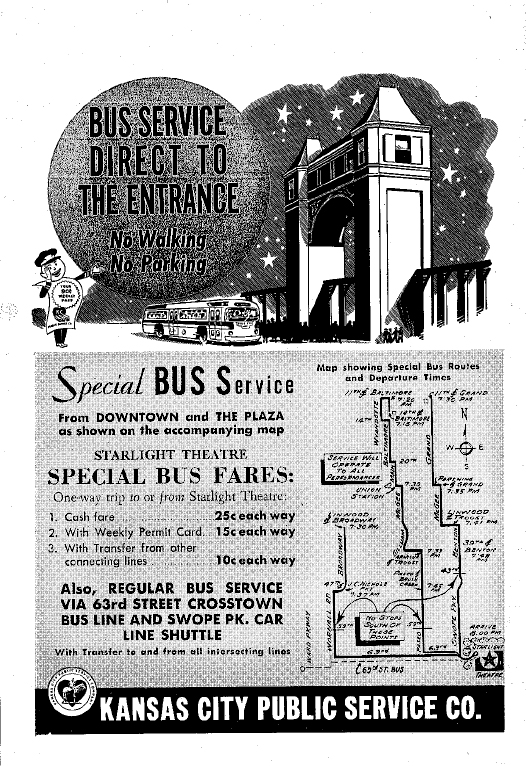
Starlight Stories: The 1950s
Starlight Stories: The 1950s
As we approach the 75th anniversary of Starlight Theatre in 2025, we’re taking a look at the history of the venue, decade by decade. Today, we’re looking at the 1950s.
Starlight opened in 1950, but the plan began well before that. “The Starlight Story” was written by Jim McQueeny and appeared in serial form in the program books in the inaugural 1951 season. It begins simply:
“At one time or another every community has a hankering for an outdoor theatre. The idea kicked around here for years but didn’t make any headway until the middle twenties when the Kansas City Federation of Music Clubs set about to raise funds for an outdoor amphitheatre.”
Planning An Outdoor Theatre for Kansas City

By the mid-1940s, discussions of an “outdoor stage” for Kansas City had been under way for two decades. While an outdoor theatre was low on the city’s list of priorities, plans for a ceremony to celebrate Kansas City’s 100th anniversary added urgency.
A committee was quickly chosen, Swope Park was deemed the location, and construction began in December 1949.
On June 3, 1950, in a facility not yet fully complete, the historical revue, Thrills of a Century, opened at Starlight Theatre. The show played nightly through July 10.
Hundreds of local citizens participated in the pageant, and thousands turned out each night. Show highlights included the staging of the Battle of Westport, a Gay ‘90s revue, and the original locomotive that crossed the Hannibal Bridge 81 years before chugging across the stage on specially-built rails.
A Theatre for the Entire Family
The pageant’s success prompted the Kansas City Missouri Park Board to move ahead with plans to complete Starlight. Seeking to create a not-for-profit organization to activate and run the theatre going forward, 586 Kansas Citians contributed $10 each to become charter members of the new Starlight Theatre Association.
On June 25, 1951, Edward Delk’s iconic designs for the stage, sloped seating area, light pylons flanking the stage, and light bridge behind the seating areas were all fully in place. Starlight opened its first Broadway season with The Desert Song.

“This is a theatre where people can relax and enjoy themselves. These shows are for the entire family.”
— Richard H. Berger, Starlight’s first Production Director (pictured with Carol Burnett)
Ticket prices began at 65 cents with 400 free seats available for each performance on a first-come, first-served basis. This began Starlight’s legacy of accessibility to everyone at a cost “within most everyone’s pocketbook.”

There was also a special bus route from downtown and The Plaza with direct service to the entrance of the theatre, as well as regular bus service on other lines. Direct fare was 25 cents each way or 15 cents each way with a weekly permit card.
An electric carillon was given to Starlight and was used to perform periodic concerts to remind visitors to Swope Park of the ongoing season. A program book explained how the carillon works: “Utilizing but a few ounces of metal the carillons produce bell tones as authentic as the ringing blow of a great clapper upon tones of tuned bronze.”
Seasons in Starlight’s first decade consisted of 10 shows, including a mix of operettas, light opera, and new musical comedies recently written for the Broadway stage. Production included Carmen as Starlight’s first opera (1954), Liberace as its first variety show (1957), and the world premiere of Tom Sawyer (1958).
Other 1950s high points include:
1951: The 10-show lineup in Starlight’s inaugural season featured The Desert Song, Rio Rita, Song of Norway, Roberta, Rose Marie, The Chocolate Soldier, Brigadoon, Bittersweet, Babes in Toyland, and Naughty Marietta. See below for the full show seasons in the 1950s.
1954: After replacing its stage annually during the first three years of operation due to year-round exposure to the elements, Starlight installed a permanent stage. The 1954 stage was built in 16 sections that allowed for removal and storage at the end of each season. The giant stage came out of storage each spring to be reassembled, sanded and painted for the new season. The stage lasted 33 years.
1954: Patrons’ calls for some sort of shelter from the rain were answered with the construction of pergolas on each side of the audience areas. The original pergolas are still in place today.
1958: After the opening of The Jerry Lewis Show in June, Lewis expressed disappointment with the sizable distance between the Starlight stage and the audience. To bridge the gap, he proposed the stage be extended to cover the orchestra pit. When Starlight leaders determined the project’s cost was not feasible, Lewis decided to pay for it himself. By 8 a.m. the next day, the lumber needed had arrived. Starlight’s lead carpenter and a crew of 10 toiled in 100-degree heat to build a temporary stage on which Lewis performed that same night.
Broadway Show History – 1950s
The Desert Song
Rio Rita
Song of Norway
Roberta
Rose Marie
The Chocolate Soldier
Brigadoon
Bittersweet
Babes in Toyland
Naughty Marietta
The Great Waltz
Good News
The Vagabond King
Where’s Charley?
The Firefly
Carousel
Robin Hood
East Wind
The Red Mill
Show Boat
The Student Prince
The Wizard of Oz
The Merry Widow
Bloomer Girl
On Your Toes
Up in Central Park
New Moon
Kiss Me Kate
Blossom Time
Annie Get Your Gun
all Me Madam
Sweethearts
Three Musketeers
Girl Crazy
Carmen
Gentlemen Prefer Blondes
Hit the Deck
Song of Norway
No No Nanette
Oklahoma!
Naughty Marietta
Me and Juliet
Babes in Toyland
Guys and Dolls
Bittersweet
Finian’s Rainbow
Cole Porter Festival
Brigadoon
Wonderful Town
South Pacific
Peter Pan
Kismet
Best Foot Forward
The Desert Song
Annie Get Your Gun
Plain and Fancy
The Chocolate Soldier
Paint Your Wagon
Wish You Were Here
The King and I
Liberace
South Pacific
High Button Shoes
Can Can
By the Beautiful Sea
The Pajama Game
Panama Hattie
Silk Stockings
Damn Yankees
Show Boat
The Jerry Lewis Show
Fanny
Happy Hunting
Rosalinda
Kiss Me Kate
Tom Sawyer
Carousel
The Wizard of Oz
Guys and Dolls
The Most Happy Fella
Oklahoma!
The Firefly
Gentlemen Prefer Blondes
Tom Sawyer
Say, Darling
New Moon
The Great Waltz
Bells are Ringing
Li’l Abner
Read About Other Decades at Starlight
1960s
1970s
1980s
1990s
2000s